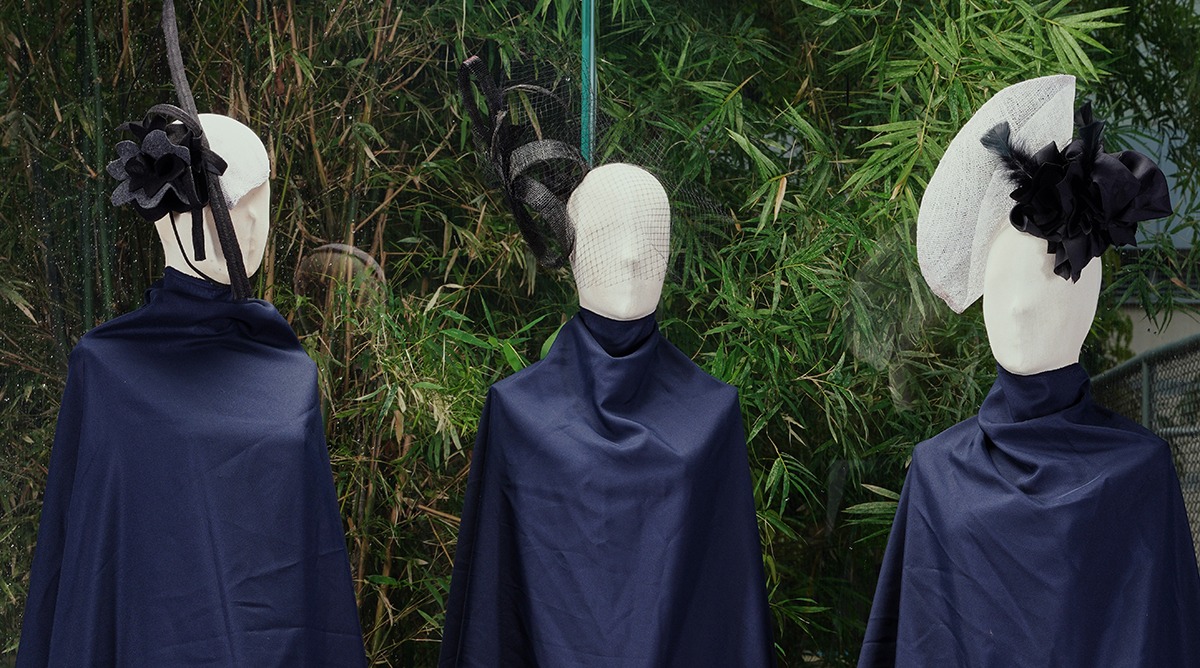
College of Design, Rangsit University
Ananyalan Wattananupong

Abstract :
Millinery refers to the art and craft of designing and making hats and headwear, often decorated with various materials like fabric, flowers, feathers, or other embellishments. It has had a significant place in fashion history, particularly during the Victorian era and the 1920s.
History of Millinery:
- Medieval and Renaissance periods: The wearing of hats began to gain importance in European society, with hats reflecting one’s social status and personality. During this time, hats were more functional and less focused on fashion design.
- 16th-17th centuries: Hat production became more intricate, especially in France and Italy, where hats were used to display wealth and status. This period saw the beginning of more decorative and fashionable designs.
- Victorian Era (1837-1901): Hats became crucial in women’s fashion during this period, often large and lavishly decorated with flowers, ribbons, and satin. Millinery was a skilled craft typically done by women and gained popularity.
Objectives :
- Reflect the balance between gentleness and confidence: Design hats with delicate, graceful lines that subtly convey strength and power, allowing the wearer to feel both elegant and confident.
- Create wearable pieces of art: Focus on designs that are not only beautiful and unique but also comfortable and practical for everyday use.
- Empower the identity and personality of modern women: Support the idea of women who are gentle but not fragile, graceful yet not confined by traditional boundaries.
- Add new dimensions to millinery fashion: Combine traditional craftsmanship with contemporary ideas, transforming hats into more than accessories—into true reflections of personal style and identity.
- Design for versatile occasions: Create hat designs suitable for a wide range of settings—from formal events to striking fashion-forward looks.
- Use high-quality materials and construction: Select materials that are both soft and durable to ensure long-lasting wear and structural integrity.
Conceptual Framework :
Designing a soft yet confident millinery piece involves blending delicate aesthetics with a strong sense of self. The goal is to create headwear that is both elegant and empowering, embodying femininity without fragility.
- Inspiration
- Nature & Florals: Inspired by the soft curves of petals, vines, and butterfly wings—delicate yet structured.
- Victorian & Art Deco Influence: A fusion of intricate vintage elegance with bold, geometric sophistication.
- Modern Femininity: Representing contemporary women who embrace both grace and inner strength through clean yet expressive designs.
- Shape & Structure
- Soft curves and organic lines, but with defined, confident edges.
- Lightweight yet sturdy frameworks, such as wired bases that maintain their shape while allowing for movement.
- Asymmetry to add modern elegance and a sense of individuality.
- Materials
- Fine fabrics like silk, tulle, for a soft, romantic feel.
- Sheer or feathered elements for a touch of ethereal beauty.
- Leather or velvet accents to contrast softness with confidence.
- Colors & Patterns
- Contrasting hues like deep navy, black, or burgundy to add strength and presence.
- Patterns incorporating floral motifs or modern geometric shapes for a balanced aesthetic.
- Embellishments
- Small feather details or sculpted bows for an added sense of movement.
- Functionality & Wearability
- Designed for practicality—lightweight and comfortable for extended wear.
- Versatile for different occasions, from weddings to formal gatherings.
- Secure yet non-restrictive fit, ensuring ease of movement and confidence
Process / Methodology :
Creating hats under the concept of “Soft but Confident” requires meticulous craftsmanship and techniques that balance delicate design with structural integrity. The form must be defined yet graceful, combining softness with stability. The design and creation process can be divided into six main stages as follows:
- Concept Development & Inspiration
- Explore forms that convey softness, such as curves, flowers, vines, or flowing fabrics.
- Combine these with elements of strength and stability, such as geometric lines, dimensional structures, or bold color contrasts.
- Sketching & Prototyping
- Create sketches of the hat’s structure and design, focusing on the harmony between gentle elegance and bold confidence.
- Design secure fastening systems to ensure comfort and stability during wear.
Techniques and Materials :
Material Selection
- Use materials that evoke a sense of softness, such as:
- Tulle, lining fabrics, and mesh—these provide a light, airy, and romantic feel.
- Feathers—add a sense of lightness and a soft, delicate appearance.
- Incorporate materials that enhance a sense of confidence, such as:
- Wire frames—provide structural strength and support a more stable, confident design.
- Contrasting colors—add boldness and a stronger visual impact.
Foundation & Construction
- Use traditional hat-blocking techniques appropriate to the selected materials, such as:
- Steam blocking or wet molding with straw or leather.
- Build a stable foundation using techniques that suit the design, such as:
- Wire framing—for hats that require lightness and fluidity.
- Buckram stiffening—for hats that need a more defined and structured form.
- Install fastening systems, such as combs, headbands, or ribbons, to ensure secure and comfortable wear.
Embellishments & Finishing Touches
- Decorate hats with elements that strike a balance between softness and confidence, such as:
- Elegant feathers or structured ribbons that reflect both grace and strength.
- Ensure neatness and quality of stitching and attachment for a polished appearance—inside and out.
Result / Conclusion :
Summary of the Millinery Approach: “Soft but Confident” Style
- The structure should be stable, while the design remains soft and flowing.
- Use gentle, delicate materials combined with elements that evoke confidence.
- Apply refined, detailed embellishments with consideration for comfort and wearability.
- Emphasize experimentation and customization to suit the actual wearer.